Pysanki Eggs - Top Selling Polish Pottery Patterns
- Posted on
- By Cindy DeLong
- Posted in Best Polish Pottery Selection, Best Selection Of Mosquito Pottery, Best Selling Polish Pottery Plate, Best Zaklady Polish Pottery Selection, Ceramika Artystyczna Polish Pottery, Hand Painted Boleslawiec Pottery, Hand Painted Ceramic Bowls, Hand Painted Ceramic Pottery, Hand Painted Polish Pottery Bowl, Hand Painted Polish Pottery Teapot, Handpainted Peacock Pottery, High End Polish Place Settings, Kalich Polish Stoneware, Manufaktura Polish Pottery, Polish Pottery Ceramic Mugs, Polish Stoneware Bubble Mug, Top Polish Stoneware Collections, Top Selling Polish Dinnerware, Top Selling Polish Pottery Mug, Top Selling Polish Pottery Patterns
- 4

Pysanki Eggs are an important part of the Polish Easter tradition. Colorful and festive, here is a little bit about their history and tradition.
Beautifully decorated Pysanki eggs have adorned the Polish Easter table for centuries. They symbolize life and rebirth. They are most commonly decorated with lambs, crosses, flowers, and other spring motifs. Other Slavic cultures participate in this tradition which is believed to date back over 5000 years to talismanic pagan rituals.
The Saturday before Easter, the Poles decorate hard-boiled eggs. Traditional methods for decoration involve hot wax applied to the egg shell creating a pattern. The eggs are then covered with paint, and finally when the wax is removed, the pattern is revealed. Some Poles use store-bought kits, while others make their own dyes using boiled onion skins.
Many of the decoration techniques are regional. They even include pasting dried flowers, cloth or colored paper onto the eggs. Children decorate eggs with paints, crayons, stickers, and tissue paper.
On the same day, Easter baskets are prepared and decorated with sprigs of boxwood and lined with white linens or lace. Foods are a sampling of Easter foods including pysanki eggs, a piece of ham or sausage, bread, cake, and an Easter Lamb that can be made or sugar, chocolate, or even plastic. The baskets are brought to church for a blessing by the priest.
Our owner Cindy was recently talking about this tradition with a customer Heather, who was born and raised in the U.S. and is from Polish descent. Pysanki eggs have been passed down in her family for generations. She told Cindy of her childhood memory of decorating eggs with colored tissue paper and crushed glass.
Heather's family lived in Columbia, Missouri where they continue their Polish tradition of taking their Easter Baskets to Mass where the priest blesses them.
The tradition of painting eggs and exchanging them with friends and relatives is also a long-standing part of the Easter celebration. A bowl of Pysanki eggs is a colorful display on the Easter table and serves as a protection of all dangers as well.
Wooden Pysanki Eggs made in Poland and are widely available today. Some Polish farmers paint the eggs during the winter. Very colorful, they have made their way into homes across the world and are cherished for their vibrant colors and unique designs.
Here are the meanings of the colors found in the eggs:
Red: Action, charity, spiritual awakening, sun, joy of life and love
Blue: Air, good health, truth, and fidelity
Yellow: Youth, love, harvest and the perpetuation of the family
Green: Fertility, health, hopefulness, spring, breaking bondage, freshness, wealth
Gold: Spirituality and wisdom
Orange: Endurance, strength, ambition, a symbol of everlasting sun
Pink: Success and contentment
Purple: Fasting, faith, trust and patience
White: Purity, birth, light, rejoicing, virginity
Black: Constancy or eternity, the center of the earth
Brown: Mother Earth and her bountiful gifts
If you love these colorful Pysanki Eggs as much as do, we invite you to shop our Easter collection with the top selling polish pottery patterns on Easter bunnies and eggs.



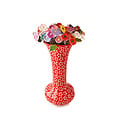
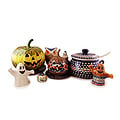

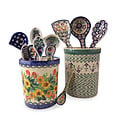
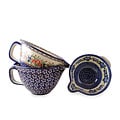
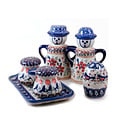
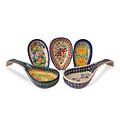


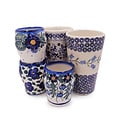
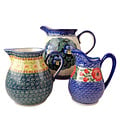

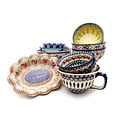


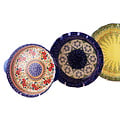

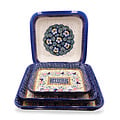
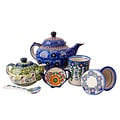

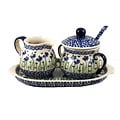

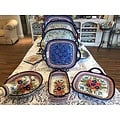

Traditionally, the decorated eggs were hollow. The contents were blown out through a tiny hole on either end. I have a collection of these that my mother's father brought to the U.S. when he came here, alone, at age 16 in 1908.
Ellen Barclay,
Chico is NOT aunt in Polish. The word is Cioci.
We always love hearing those personal stories from our customers! Thanks for sharing!
Being part Polish, I treasure the memories of me helping my Mom and Chico’s (aunt in Polish). Oloring eggs!
Enjoy seeing different designs! Hoping to share making some with our grandchildren!
What a beautiful tradition.